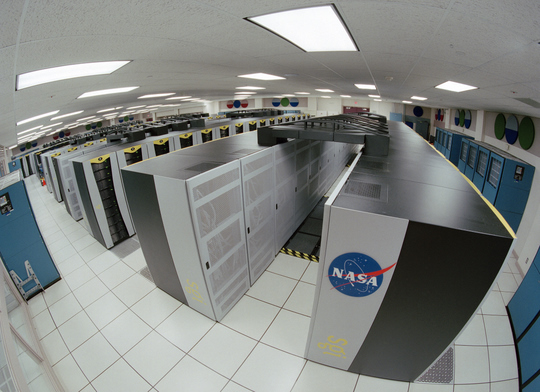NASA is collaborating with Intell and SGI to create one of the world’s fastest supercomputers whose power will be measured in petaflops. By 2009 the US space agency wants to develop a computational system that will be able to do 1,000 trillion calculations per second. And by 2012 it hopes to have boosted the power of this machine to 10 petaflops, to help with modelling and simulation. NASA’s Advanced Supercomputing Division is calling the new project Pleiades, and it will be installed at the Ames Research Center in California, the site of its current supercomputer, Columbia, pictured here. The new computer would put NASA on the list of the top five fastest number crunchers in the world.
“Throughout its history, NASA has sought to explore the most compelling questions about mankind, Earth, and the worlds that await our discovery,” said Robert “Bo” Ewald, chief executive officer of SGI. “These groundbreaking new systems powered by SGI and fueled by the latest multi-core Intel processors, offer a platform for new discoveries that will help us all achieve the most promising future for the human race. This effort is important to everyone on this planet.”
NASA uses its current supercomputer to examine the performance of hypersonic aircraft, simulate lander deployments and model fabrics for future spacesuits.
“This additional computational performance is necessary to help us achieve breakthrough scientific discoveries,” said Pete Worden, Director at Ames.
Currently, the most powerful supercomputer on Earth is BlueGene/L which has a top speed of 478.2 teraflops.
Columbia was turned on in 2004 and has a theoretical peak of 88.88 teraflops. This makes it the 20th most powerful supercomputer on the planet, according to the Top 500 Project which compiles a list of the relative performance of these machines.
Petaflop computers are expected to debut in the next release of the Top 500 list which is due in June.
Quasi-supercomputing, where multiple computers are used using the BOINC platform has already achieved petaflop status. Folding@home, reported nearly 1.3 Petaflops of processing power in late 2007.
The largest BOINC project, SETI@home, reported processing power of over 450 teraflops through almost 350,000 active computers.
Original News Sources: BBC, NASA


What about the fidelity of these calculations? Does anyone ever check the computer’s answers? What about the parameters programmed into the software, can the paradigm accurately simulate nature? Models, after all, help, us grasp complex topics by over simplification. Maybe the strength of Quantum’s in open-ended questions. Instead of determinism, nature may be probability & statistical mechanics. Roll the Petra-Dice!
To Laszio, Excellant questions. Does anyone know who or how answers are checked? Petaflop production vs. accuracy? That could be a gut-wrenching expose`.
I bet ‘Gears of War’ loads & plays like a good ‘un!
Does this mean they`ll be able to run Vista?